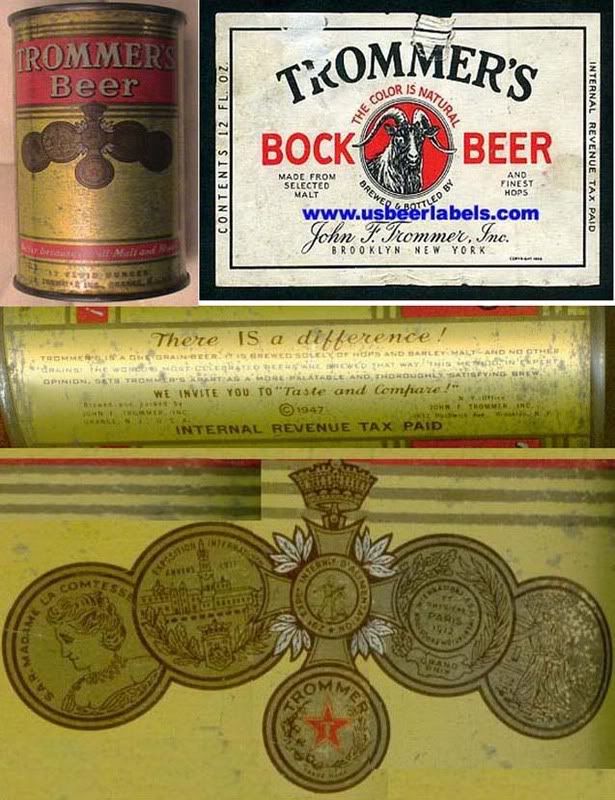
More on Trommer Beer which was being sold in 1950 at 21 Pike Street:
from rusty cans
One of my favorite late 1940s cans. I like the design, especially the medals on the front. I think these are actually TWO medals, both back and front showing. The ones on the left read "S.A.R. Madame Contesse" and "Exposition Internation (sic) Envers 1911." The ones on the right read "International Dalimentation Exposition Et Dmygiene Paris 1912" (I think, those are TINY letters!) and "Grand Prix." The center medalion reads "Internale D'Alimentation 29th Exp."
Once again we have the story of a German immigrant who sailed to America and became a giant. of the brewing industry (I'm sensing a pattern here). John F. Trommer immigrated from Hersfeld, Germany in the 1840s and settled in Portland, Maine where he worked in a small ale brewery. He eventually moved to Boston and worked in several breweries there. He moved to Brooklyn's Bushwick district where a number of breweries were congregated at some point and became brewmaster for William Ulmer. By the late 19th century there were 58 breweries in a 12 block stretch of road in this area along what was called "Brewer's Row." In 1897 Trommer bought an interest in a new company called Stehlin & Breitkopf and soon changed the name to J.F. Trommer's Evergreen Brewery. John Trommer didn't have time to enjoy his success, however, as he died in 1898 and his son George Trommer took over the brewery. speakers!
At first making only lager beer, Trommer's beer was an all-malt beer. Here's how a buddy of mine who is a professional brewer explained it. Brewers called beers (in the old days, made with 100% barley and wheat malt) "all-malt" or "malt" beers to differentiate them from the newer, cheaper beers using proportions of corn, rice, or cane sugar. Any grain can be malted (germinated to grow like the grass seed that it is, just until all the starch in the seed has been solubilized and the enzymes made to break down the starch) to use for growth, then (cruelly, to the seed) kilned and dried to kill the growth and keep the starches intact). This all happens by the time the root is 1/8 in or so long. Wanna make cheaper beer, that's lighter in body and flavor than an all-malt beer, that will appeal to more people? Use adjuncts (add junk!) like corn grits, corn starch, cane sugar, rice, rock candy (Belgium), millet if you're in Africa, you name it. Old-fashioned or wintertime hearty brews called themselves all-malt to distinguish themselves as a mark of quality. Trommer's continued making an all-malt beer until they closed in 1951. It was a constant them in their advertising.


























2 comments:
How is it that I was able to drink Trommer's White Label at Lundy's Seafood Restaurant, in Sheepshead Bay, Brooklyn, NY, in the 1970s? The beer was memorably delicious, but I found no retailer for it even at upscale Manhattan delis. Could Lundy's have had a supply of this brew stored long after the brewery closed?
In 1951 Piels bought out Trommer's and later closed the plant. It is possible that Piels continued to brew Trommer's at another brewery
Post a Comment